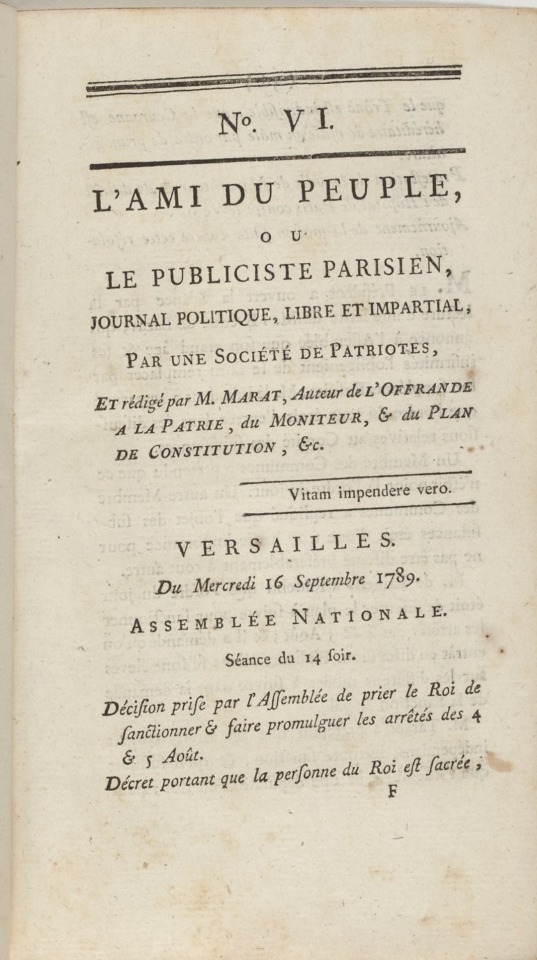#this is very personal to me sorry for the longmaratposting
Text
September 16th, 1789: 234 years ago, Jean-Paul Marat published the first issue of L'Ami Du Peuple




L'Ami du Peuple, or, as it was called at the time it was founded, L'Ami Du Peuple ou Le Publiciste Parisien, was an active revolutionary newspaper and also one of the most absolutely fascinating and interesting pieces of the entire French Revolution, created and edited by Marat from September 1789.
The year 1789 was a relatively turbulent period for both Marat's career and the history of the Revolution. This can be seen simply by the number of projects that Marat began in a short space of time. In February, just two months after publishing his Offrande à la Patrie (1788), he published the Supplément à l'Offrande (1789). In March, he began to attend the sessions of the electoral assembly of his district, Carmes-Déchaussés, with great assiduity and was soon elected to the electoral committee. In August, he began publishing Le Moniteur Patriote and also published the Projet de déclaration des droits de l'homme et du citoyen suivi d'un Plan de constitution juste, sage et libre. Finally, in September, he published No. 1 of Le Publiciste Parisien, and consequently No. 5 of the then L'Ami Du Peuple ou Le Publiciste Parisien, which marked the birth of the famous Friend of the People, a character Marat would identify with until the last day of his life. It can be said that this newspaper came about when Marat found himself in a situation where he would have to produce and publish newspapers and pamphlets independently and without the approval of his colleagues. He proposed to the committee that it should have a press, which was apparently not accepted by the district.
More than just one of the many periodicals that existed during the course of the revolution, L'Ami du Peuple is a precious historical source of information and there is no doubt that it was important for the unfolding of revolutionary events. Not even Delisle de Sales, in his Essai sur le journalisme depuis 1735 jusqu'à l'an 1800 (1811), a work that expressed the author's deep aversion to the revolutionary process and especially to Marat, denies that L'Ami Du Peuple left a mark on the philosophical memory of the history of French journalism.
Albert Mathiez, in a summary of Gottschalk's Marat in the 1927 AHRF (pp. 599-602), makes an interesting comment on Marat's analysis in the context of revolutionary journalism:
"In my opinion, what makes Marat original among the journalists and statesmen of the Revolution has not been sufficiently appreciated by M. Gottschalk. (...) He was never naïve about the revolution that was taking place. From the first moment, he proclaimed that the proletarians - an expression he had already used in its current sense - would gain nothing. (...) No other revolutionary had the same degree of feeling that the proletariat was a class distinct from the bourgeoisie. (...) What always distinguished Marat, presented as an enlightened man, was the correctness of his vision, the total absence of candor, the profound and even pessimistic realism. Marat was not only one of the most determined and precocious republicans. He also did not conceive of the Republic except in the form of direct rule."
In addition to the abundant and impressive number of issues that were written (L'Ami du Peuple had almost 700 issues in total, not counting the pamphlets and later works), it is even more astonishing when we stop to consider that a large part of all the work produced by Marat during the five years of revolution was almost entirely uninterrupted, but mainly clandestine. He managed not to be prevented even by laws (such as the decree of March 9, 1793, which obliged members of the Convention who were newspaper editors to choose between legislation and journalism) from continuing to produce and publish his writings.
Today's date is important and significant for history - the history of journalism and the revolution, but especially and undoubtedly the history of Marat. L'Ami du Peuple was, above all, a character. He is a truly dedicated patriot, brave and fearless, who cares about his fellow citizens and the people. He is an important character for Marat because the two, at a certain point, become one. L'Ami du Peuple, who initially appears as the construction of a publicity strategy, quickly becomes a kind of romantic hero of the revolution, with whom Marat identifies and whom he also uses to continue ceaselessly defending what was right for him, what fit in with his very well-founded and observed political and social principles. The previous Marat, the Marat Man of the Enlightenment, physicist, doctor and experimenter, had a passion that managed to outshine all his other interests: politics, and of that there is no doubt. Marat found himself moved by this political passion a few times before the Revolution - Chains Of Slavery (1774), for example, which was written incessantly over just three months, with mainly political aims, is living proof of Marat's burning passion in this area - but none of the times he expressed his interest was as strong and as significant for him as the creation of L'Ami du Peuple, which signified Marat's definitive entry into the revolution. L'Ami du Peuple was important to Marat because it was through it that he was able to express and make his politics heard; because L'Ami du Peuple made Marat so passionately committed to a revolution that it gave him, definitively, a homeland: the France.
#l'ami du peuple day!!! 🦦#this is very personal to me sorry for the longmaratposting#marat#l'ami du peuple#jean paul marat#french revolution#my posts
44 notes
·
View notes